2016 CHRYSLER 300 radiator cap
[x] Cancel search: radiator capPage 481 of 620
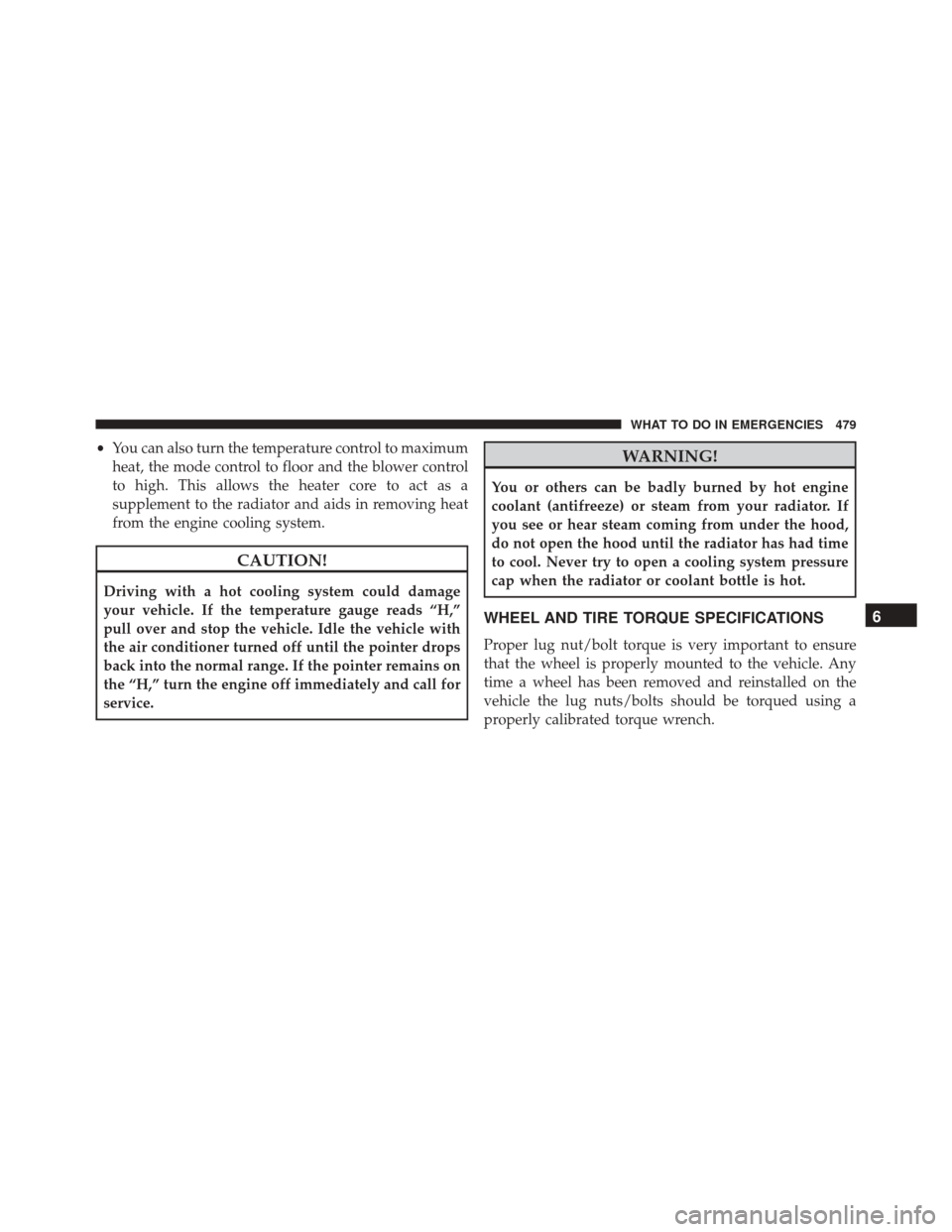
•You can also turn the temperature control to maximum
heat, the mode control to floor and the blower control
to high. This allows the heater core to act as a
supplement to the radiator and aids in removing heat
from the engine cooling system.
CAUTION!
Driving with a hot cooling system could damage
your vehicle. If the temperature gauge reads “H,”
pull over and stop the vehicle. Idle the vehicle with
the air conditioner turned off until the pointer drops
back into the normal range. If the pointer remains on
the “H,” turn the engine off immediately and call for
service.
WARNING!
You or others can be badly burned by hot engine
coolant (antifreeze) or steam from your radiator. If
you see or hear steam coming from under the hood,
do not open the hood until the radiator has had time
to cool. Never try to open a cooling system pressure
cap when the radiator or coolant bottle is hot.
WHEEL AND TIRE TORQUE SPECIFICATIONS
Proper lug nut/bolt torque is very important to ensure
that the wheel is properly mounted to the vehicle. Any
time a wheel has been removed and reinstalled on the
vehicle the lug nuts/bolts should be torqued using a
properly calibrated torque wrench.
6
WHAT TO DO IN EMERGENCIES 479
Page 530 of 620
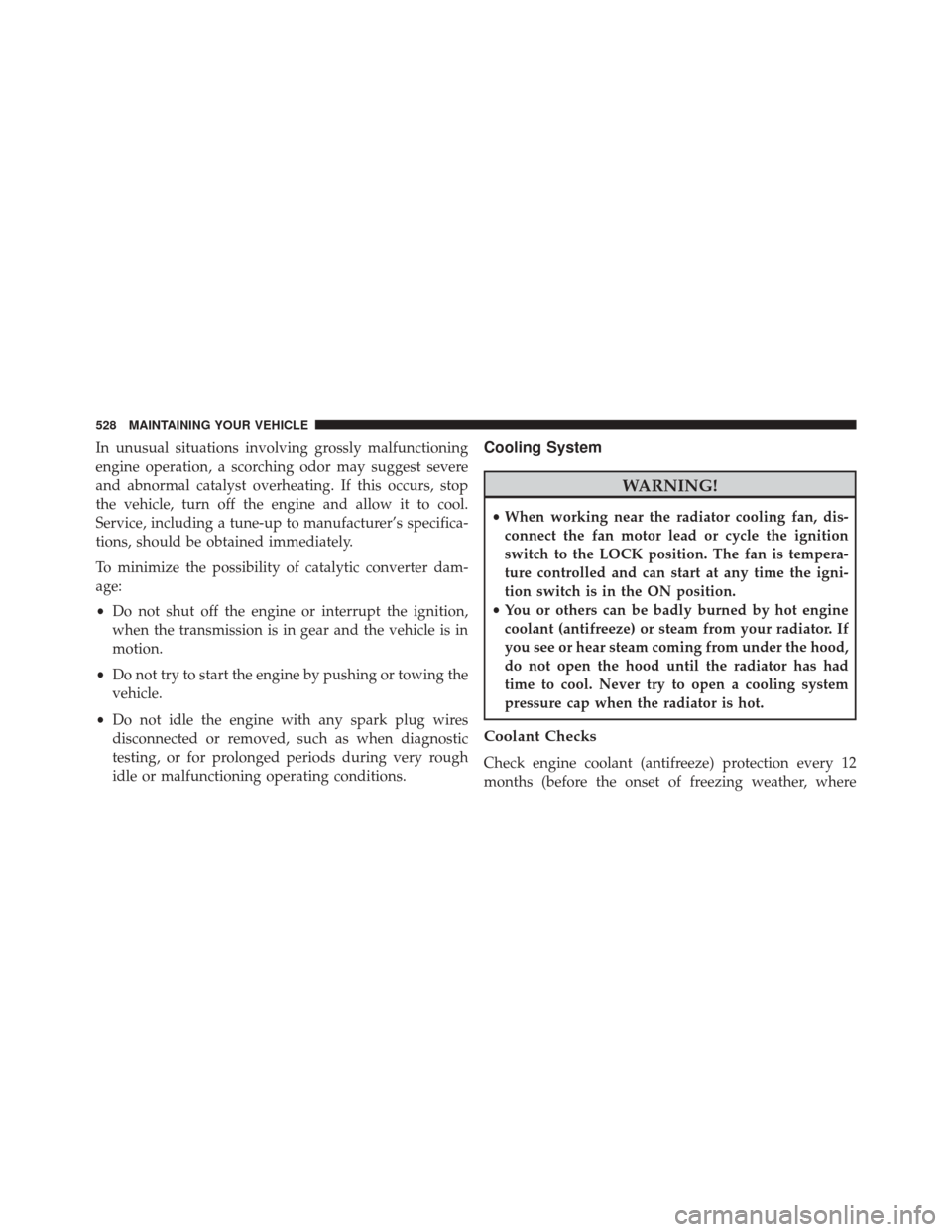
In unusual situations involving grossly malfunctioning
engine operation, a scorching odor may suggest severe
and abnormal catalyst overheating. If this occurs, stop
the vehicle, turn off the engine and allow it to cool.
Service, including a tune-up to manufacturer’s specifica-
tions, should be obtained immediately.
To minimize the possibility of catalytic converter dam-
age:
•Do not shut off the engine or interrupt the ignition,
when the transmission is in gear and the vehicle is in
motion.
• Do not try to start the engine by pushing or towing the
vehicle.
• Do not idle the engine with any spark plug wires
disconnected or removed, such as when diagnostic
testing, or for prolonged periods during very rough
idle or malfunctioning operating conditions.Cooling System
WARNING!
• When working near the radiator cooling fan, dis-
connect the fan motor lead or cycle the ignition
switch to the LOCK position. The fan is tempera-
ture controlled and can start at any time the igni-
tion switch is in the ON position.
• You or others can be badly burned by hot engine
coolant (antifreeze) or steam from your radiator. If
you see or hear steam coming from under the hood,
do not open the hood until the radiator has had
time to cool. Never try to open a cooling system
pressure cap when the radiator is hot.
Coolant Checks
Check engine coolant (antifreeze) protection every 12
months (before the onset of freezing weather, where
528 MAINTAINING YOUR VEHICLE
Page 531 of 620
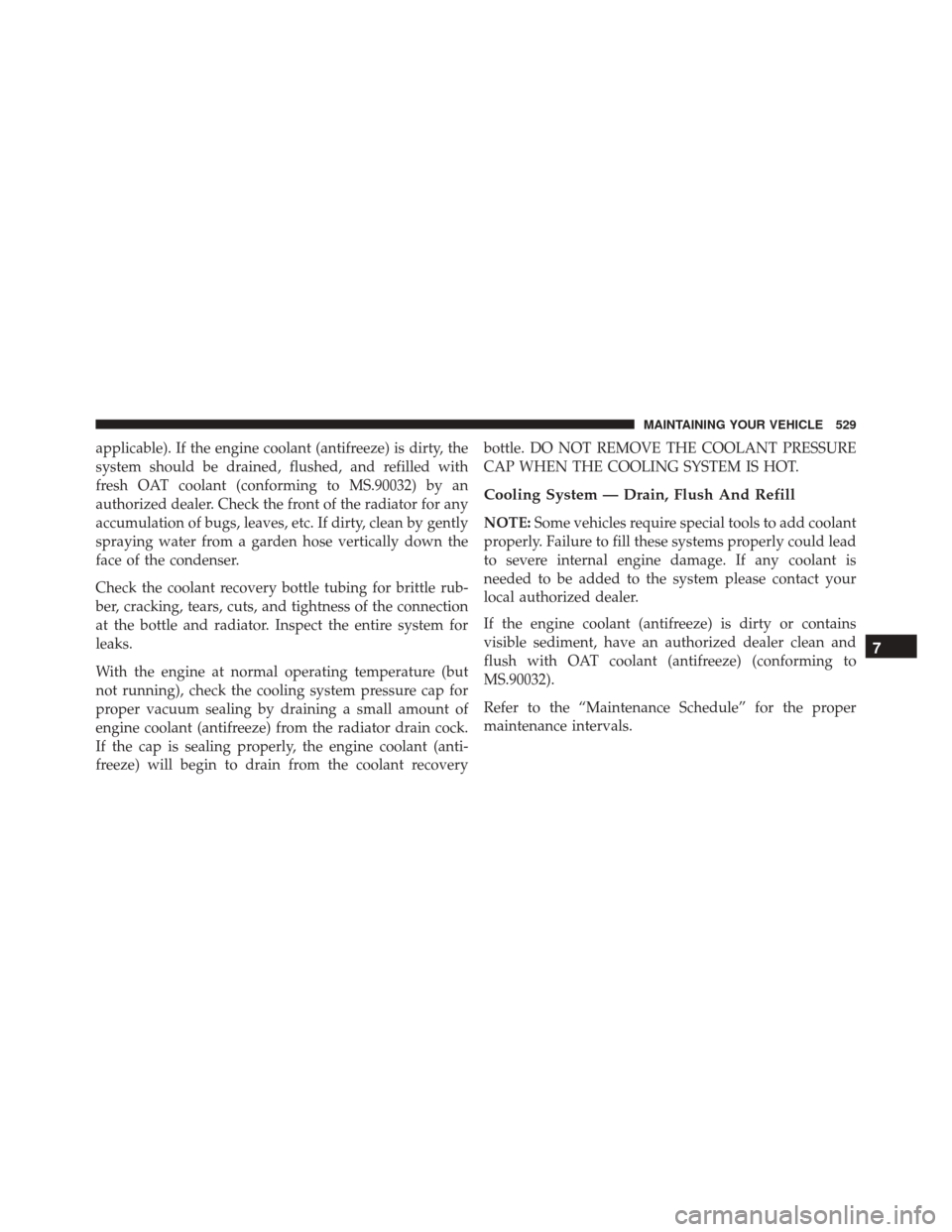
applicable). If the engine coolant (antifreeze) is dirty, the
system should be drained, flushed, and refilled with
fresh OAT coolant (conforming to MS.90032) by an
authorized dealer. Check the front of the radiator for any
accumulation of bugs, leaves, etc. If dirty, clean by gently
spraying water from a garden hose vertically down the
face of the condenser.
Check the coolant recovery bottle tubing for brittle rub-
ber, cracking, tears, cuts, and tightness of the connection
at the bottle and radiator. Inspect the entire system for
leaks.
With the engine at normal operating temperature (but
not running), check the cooling system pressure cap for
proper vacuum sealing by draining a small amount of
engine coolant (antifreeze) from the radiator drain cock.
If the cap is sealing properly, the engine coolant (anti-
freeze) will begin to drain from the coolant recoverybottle. DO NOT REMOVE THE COOLANT PRESSURE
CAP WHEN THE COOLING SYSTEM IS HOT.
Cooling System — Drain, Flush And Refill
NOTE:
Some vehicles require special tools to add coolant
properly. Failure to fill these systems properly could lead
to severe internal engine damage. If any coolant is
needed to be added to the system please contact your
local authorized dealer.
If the engine coolant (antifreeze) is dirty or contains
visible sediment, have an authorized dealer clean and
flush with OAT coolant (antifreeze) (conforming to
MS.90032).
Refer to the “Maintenance Schedule” for the proper
maintenance intervals.
7
MAINTAINING YOUR VEHICLE 529
Page 534 of 620
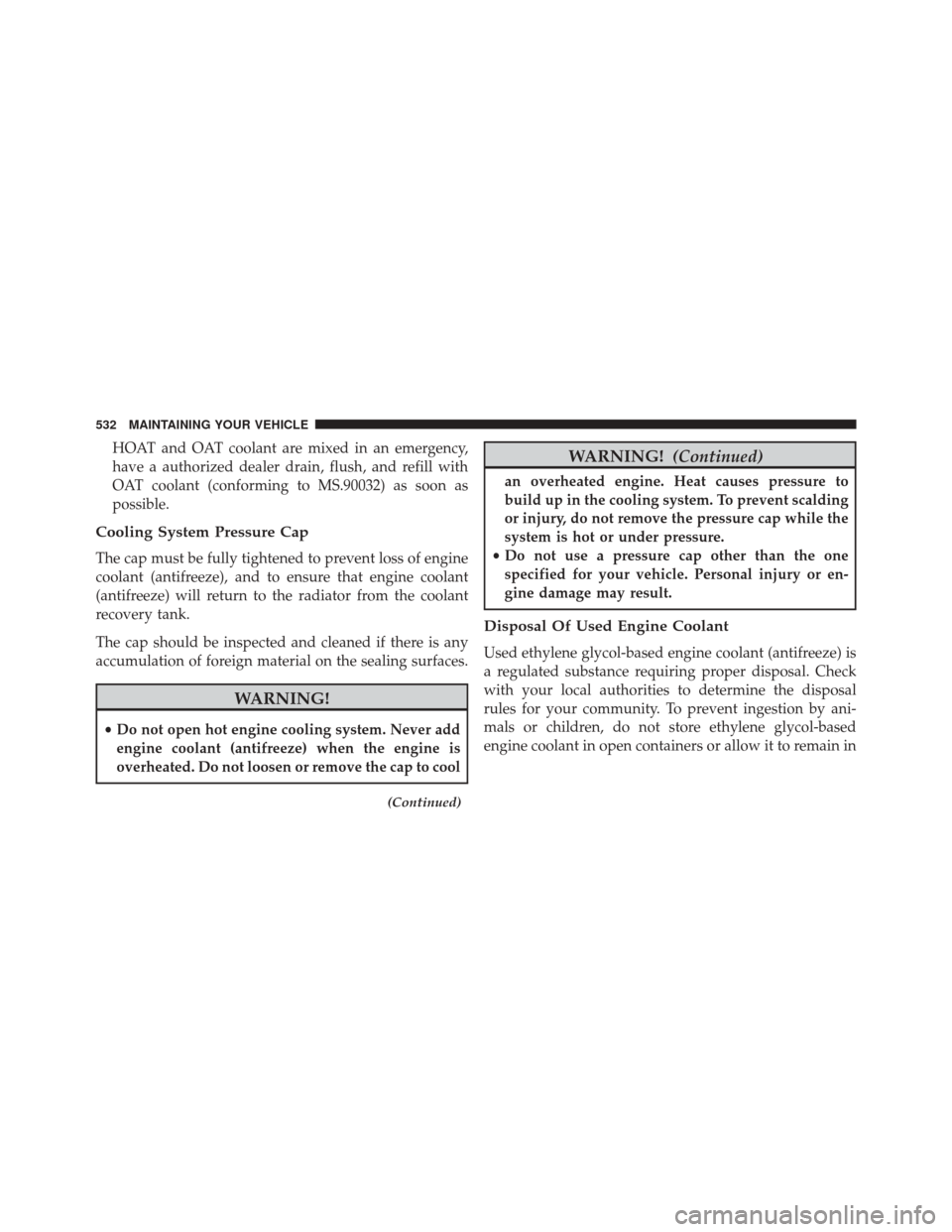
HOAT and OAT coolant are mixed in an emergency,
have a authorized dealer drain, flush, and refill with
OAT coolant (conforming to MS.90032) as soon as
possible.
Cooling System Pressure Cap
The cap must be fully tightened to prevent loss of engine
coolant (antifreeze), and to ensure that engine coolant
(antifreeze) will return to the radiator from the coolant
recovery tank.
The cap should be inspected and cleaned if there is any
accumulation of foreign material on the sealing surfaces.
WARNING!
•Do not open hot engine cooling system. Never add
engine coolant (antifreeze) when the engine is
overheated. Do not loosen or remove the cap to cool
(Continued)
WARNING! (Continued)
an overheated engine. Heat causes pressure to
build up in the cooling system. To prevent scalding
or injury, do not remove the pressure cap while the
system is hot or under pressure.
• Do not use a pressure cap other than the one
specified for your vehicle. Personal injury or en-
gine damage may result.
Disposal Of Used Engine Coolant
Used ethylene glycol-based engine coolant (antifreeze) is
a regulated substance requiring proper disposal. Check
with your local authorities to determine the disposal
rules for your community. To prevent ingestion by ani-
mals or children, do not store ethylene glycol-based
engine coolant in open containers or allow it to remain in
532 MAINTAINING YOUR VEHICLE
Page 535 of 620
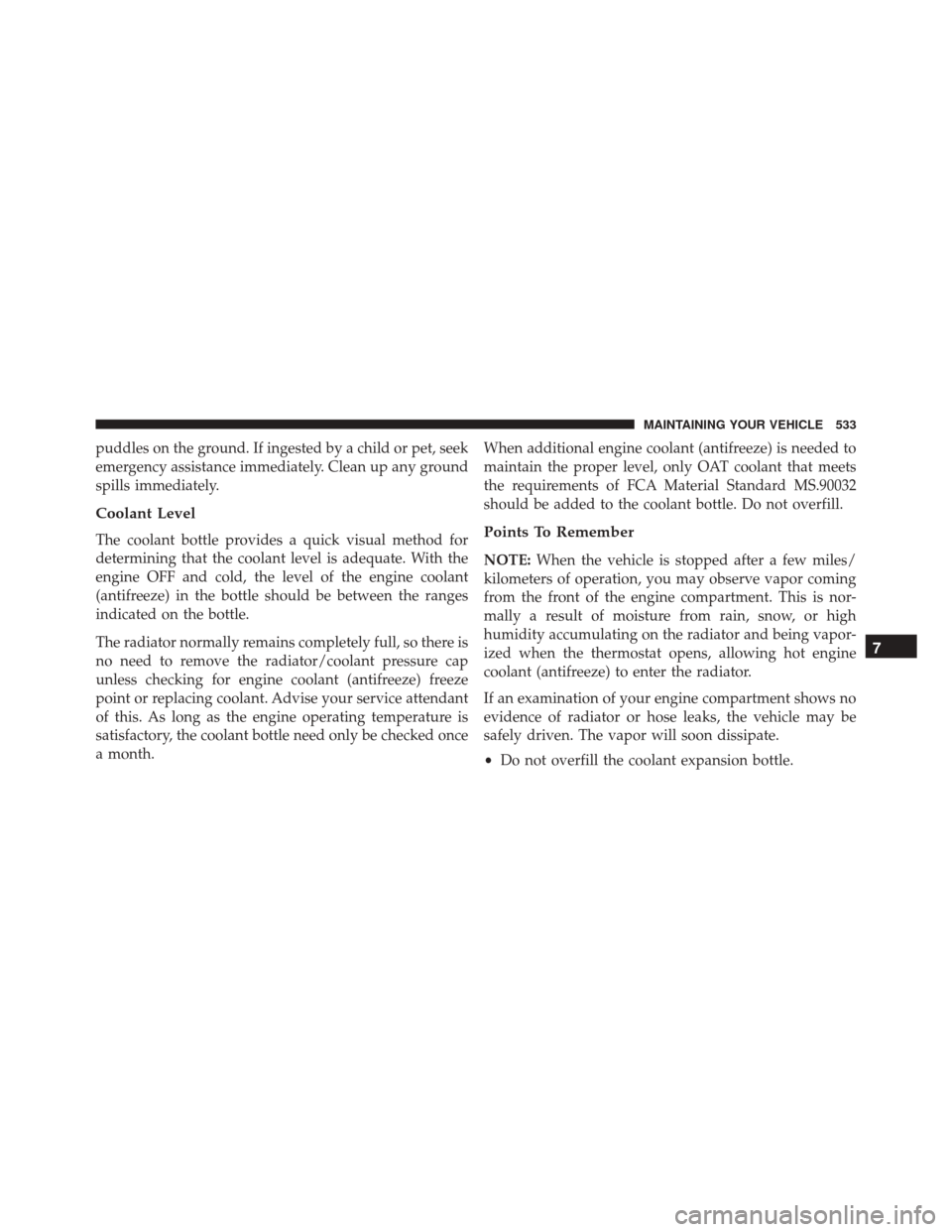
puddles on the ground. If ingested by a child or pet, seek
emergency assistance immediately. Clean up any ground
spills immediately.
Coolant Level
The coolant bottle provides a quick visual method for
determining that the coolant level is adequate. With the
engine OFF and cold, the level of the engine coolant
(antifreeze) in the bottle should be between the ranges
indicated on the bottle.
The radiator normally remains completely full, so there is
no need to remove the radiator/coolant pressure cap
unless checking for engine coolant (antifreeze) freeze
point or replacing coolant. Advise your service attendant
of this. As long as the engine operating temperature is
satisfactory, the coolant bottle need only be checked once
a month.When additional engine coolant (antifreeze) is needed to
maintain the proper level, only OAT coolant that meets
the requirements of FCA Material Standard MS.90032
should be added to the coolant bottle. Do not overfill.Points To Remember
NOTE:
When the vehicle is stopped after a few miles/
kilometers of operation, you may observe vapor coming
from the front of the engine compartment. This is nor-
mally a result of moisture from rain, snow, or high
humidity accumulating on the radiator and being vapor-
ized when the thermostat opens, allowing hot engine
coolant (antifreeze) to enter the radiator.
If an examination of your engine compartment shows no
evidence of radiator or hose leaks, the vehicle may be
safely driven. The vapor will soon dissipate.
• Do not overfill the coolant expansion bottle.
7
MAINTAINING YOUR VEHICLE 533
Page 598 of 620

Battery............................ .277, 519
Charging System Light ...................277
Keyless Transmitter Replacement (RKE) ........25
Location ............................. .519
Remote Battery Replacement ................25
Transmitter Battery Replacement .............25
Belts, Seat .............................. .101
Beverage Holder Cooled (Cupholder) ...........252
Beverage Holder Heated (Cupholder) ...........252
Body Mechanism Lubrication .................524
B-Pillar Location ......................... .423
Brake Assist System ...................... .406
Brake Control System, Electronic ..............403
Brake Fluid ......................... .568, 571
Brake, Parking .......................... .400
Brakes ................................ .402
Brake System ........................ .402, 534
Fluid Check ....................535, 568, 571
Master Cylinder ....................... .535Parking
............................. .400
Warning Light ..................... .274, 402
Brake/Transmission Interlock .................383
Brightness, Interior Lights ...................162
Bulb Replacement ..................... .560, 563
Bulbs, Light ......................... .103, 560
Camera, Rear ........................... .229
Capacities, Fluid ......................... .566
Caps, Filler Oil (Engine) .......................... .517
Radiator (Coolant Pressure) ................532
Carbon Monoxide Warning ...............100, 454
Cargo Area Features ...................... .260
Cargo Compartment ...................... .260
Cargo (Vehicle Loading) ....................461
Car Washes ............................ .540
Certification Label ........................ .462
Chains,
Tire ............................ .440
596 INDEX
Page 599 of 620

Changing A Flat Tire...................... .481
Chart, Tire Sizing ........................ .418
Check Engine Light (Malfunction Indicator Light) . .511
Checking Your Vehicle For Safety ...............99
Checks, Safety ............................99
Child Restraint ............................77
Child Restraints Booster Seats ...........................82
Center Seat LATCH ......................90
Child Restraints .........................77
Child Seat Installation .....................95
How To Stow An Unused ALR Seat Belt ........91
Infants And Child Restraints ................80
Install A LATCH-Compatible Child Restraint ....90
Lower Anchors And Tethers For Children .......84
Older Children And Child Restraints ..........80
Seating Positions ........................83
Child Safety Locks .........................35
Clean Air Gasoline ....................... .451Cleaning
Wheels .............................. .542
Climate Control ......................... .338
Automatic ........................... .338
Clock ................................. .314
Coin Holder ............................ .255
Cold Weather Operation ....................379
Compact Disc (CD) Maintenance ..............337
Compact Spare Tire ....................... .435
Connector UCI................................ .334
Universal Consumer Interface (UCI) ..........334
Console, Floor .......................... .255
Contract, Service ......................... .585
Coolant Pressure Cap (Radiator Cap) ...........532
Cooling System .......................... .528
Adding Coolant (Antifreeze) ...............530
Coolant Capacity ...................... .566
Coolant Level ..................... .528, 533
10
INDEX 597
Page 600 of 620
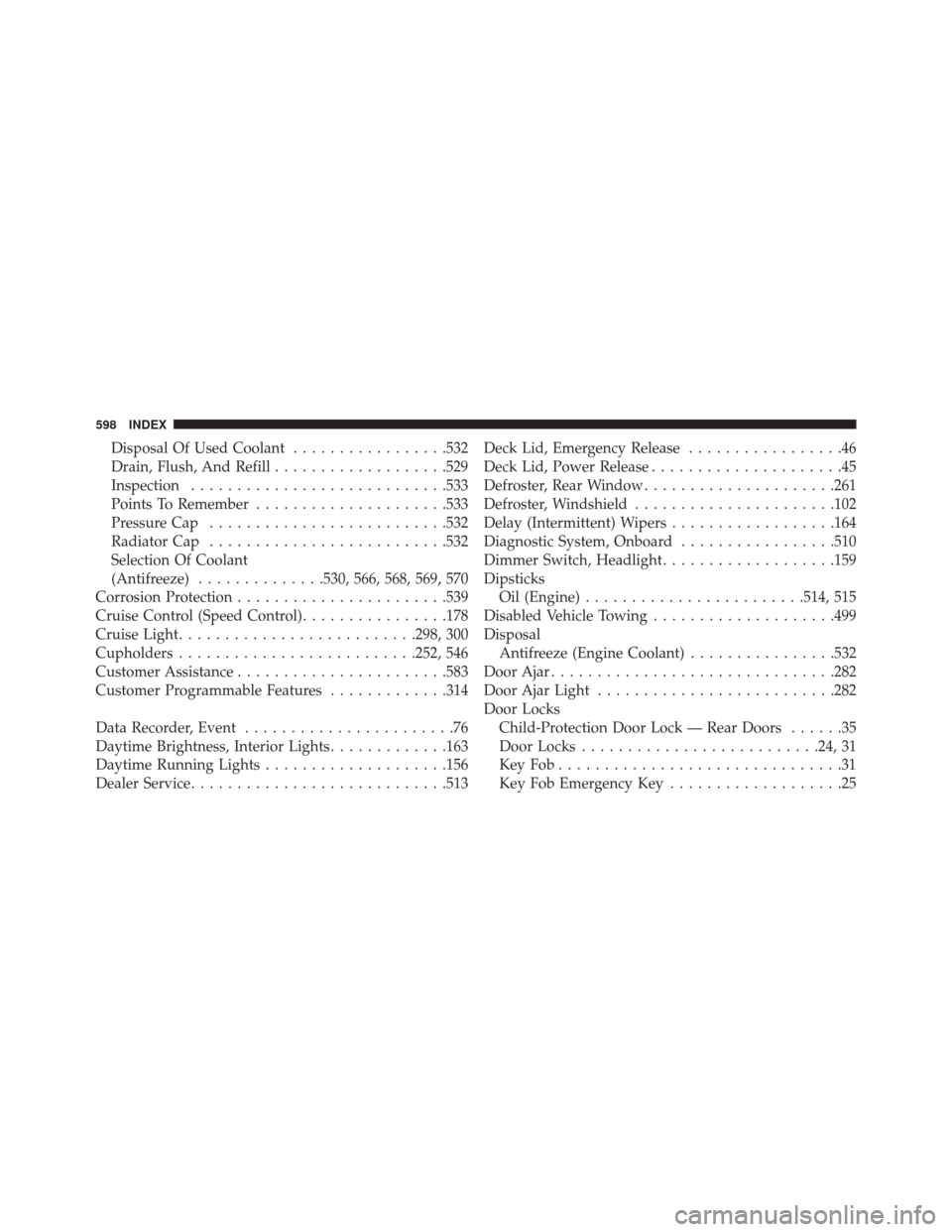
Disposal Of Used Coolant.................532
Drain, Flush, And Refill ...................529
Inspection ........................... .533
Points To Remember .....................533
Pressure Cap ......................... .532
Radiator Cap ......................... .532
Selection Of Coolant
(Antifreeze) ..............530, 566, 568, 569, 570
Corrosion Protection ...................... .539
Cruise Control (Speed Control) ................178
Cruise Light ......................... .298, 300
Cupholders ......................... .252, 546
Customer Assistance ...................... .583
Customer Programmable Features .............314
Data Recorder, Event .......................76
Daytime Brightness, Interior Lights .............163
Daytime Running Lights ....................156
Dealer Service ........................... .513Deck Lid, Emergency Release
.................46
Deck Lid, Power Release .....................45
Defroster, Rear Window .....................261
Defroster, Windshield ..................... .102
Delay (Intermittent) Wipers ..................164
Diagnostic System, Onboard .................510
Dimmer Switch, Headlight ...................159
Dipsticks Oil (Engine) ....................... .514, 515
Disabled Vehicle Towing ....................499
Disposal Antifreeze (Engine Coolant) ................532
Door Ajar .............................. .282
Door Ajar Light ......................... .282
Door Locks Child-Protection Door Lock — Rear Doors ......35
Door Locks ......................... .24, 31
KeyFob...............................31
Key Fob Emergency Key ...................25
598 INDEX